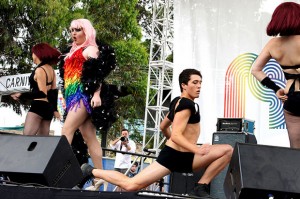
Citing both their historical importance in “creating acceptance and awareness of the gay community by wider society” and helping generate respect from a younger generation by showing them how drag queens have been able to allow them “to be able to do what they do now,” Ricky Beirao has created the What A Drag! Exhibit for this year’s hugely popular Midsumma Festival.
The festival, being held simultaneously in Melbourne and Victoria, is an approximately three-week celebration which, according to their Web site, “brings a diverse mix of artists and performers together under a single umbrella for an impassioned celebration and innovative presentation of queer arts and culture. The festival program is made up of a wide range of events and activities including visual art, theater, spoken word, cabaret, film, live music, parties, sport, social events and public forums.”
The exhibit traverses each of the last 50 decades, highlighting the social milieu in which they found themselves in. ‘Keeping it underground’ marks the 1950s and ’60s, a period of austere repression when drag queens where forced to perform in underground clubs and at private parties in people’s homes. Arrests were frequent but left drag queens undaunted. As in the states, Australian drag queens witnessed great change in the 1970s. ‘Australia’s social revolution’ marked the first time drag queen revues came out. It also saw the opening of several iconic clubs including Trisha’s Coffee Shop and Pokey’s. “Les Girls were the storm troopers to start the revolution of people being able to do what they love and being who they are,” Mr Beirao said, referring to the popular drag act that came to Melbourne in the 1960s.
By 1981, the Hamer government had decriminalized homosexuality and the age of consent was lowered to 18 for gay men and women. But ‘the gay plague,’ as it was then initially called, became the overriding concern during a period the exhibit has labeled ‘Neon lights, perms and the fight against AIDS.’ “Drag played an important role in raising awareness and preventing the spread of the disease amongst the gay community. During acts, performers were known to throw condoms at the audience and hold fundraisers at popular venues like Pokey’s.” (See the now-famous Gay Plague advert from Australia from 1987 below:)
Helped, in part, but the widely successful film, Priscilla, Queen of the Desert, the 1990s marked a pinnacle of sorts for the drag community. The drag scene was booming along Melbourne’s Commercial Road in the 1990s and contests for ‘drag excellence’ were common. The exhibit rightly reflects this decade as ‘Melbourne’s ‘golden era’ of drag.
But as the 2000s approached, drag’s popularity was on the decline. Jenna James, one half of the famed duo Drags Aloud – with Amanda Monroe – observes, in the absence of any remaining shock factor, that “you have to have some talent and you have to have something intelligent to say. The other side of the shock factor is fear, and fear leads to hatred and to violence, so I’m more than happy to walk down the street like this and not be noticed.”
The exhibit is on display until Feb. 8.











